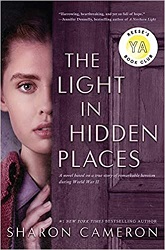
 The Light in Hidden Places
The Light in Hidden PlacesReview posted February 15, 2021.
Scholastic Press, 2020. 391 pages.
Starred Review
Review written October 24, 2020, from a library book
2020 Sonderbooks Stand-out:
#10 General Teen Fiction
The Light in Hidden Places is a Holocaust novel, so don’t pick it up if you want something cheery. The book tells a true story, though, which gives you hope that the main character is going to come through. In fact, if I hadn’t known it was based on a true story, there was no way I would have believed the characters survived many of the things that happened in this book. If the author had invented them, I would have said it was way over the top with the danger.
The story is of Fusia, a Catholic teenage Polish girl who gets a job in the shop of a Jewish family in 1939 while living in town with her sisters. When the Russians come and her home is bombed, she ends up living with the Jewish family. But the Germans are next, and after awhile, they send the Jewish family to the ghetto. It seems like a safe place for them, and Fusia finds ways to get them food. No one really believes the rumors when some of them get sent on trains to work camps.
As the war goes on, Fusia tries to visit her family on the farm, and finds them gone (sent to a different labor camp in Salzburg), but her young sister Helena alone there and starving. She takes Helena back to the town. And then she gets asked to hide one of the brothers from her Jewish family, for just one night. One night stretches out. She ends up hiding more people. I won’t even say how many Jews she ends up hiding because it seems impossible.
As the war goes on, the chance that Fusia and Helena will be able to keep these people hidden – while also healthy and not starving – gets worse and worse. For some of the time, there are even Nazis living under the same roof. The tension is high, and once I got more than halfway through, I couldn’t stop reading. I kept thinking they couldn’t possibly get through the next crisis.
And the story is all true. Photographs and the Author’s Note at the back give us details. But the author makes it all feel immediate and gripping. This isn’t dry and dusty history at all.
